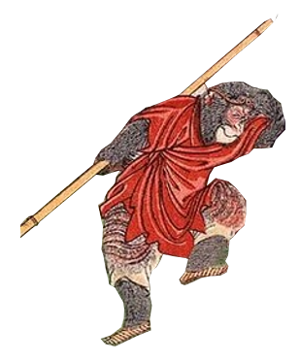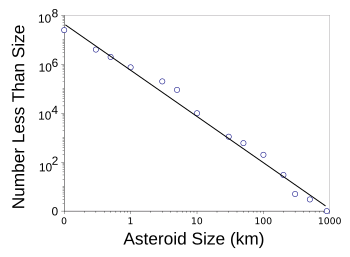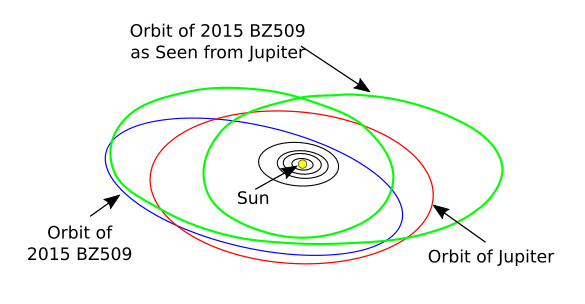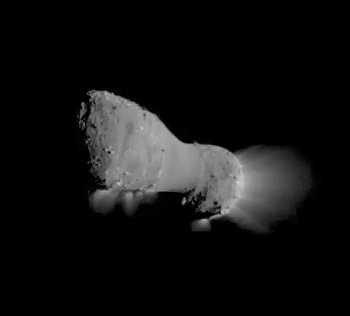Asteroid 2015 BZ509
May 8, 2017
Naming
Solar System bodies was easier in prior
centuries, when there were just six
planets (
seven if the
Moon is counted as a planet).
Galileo's telescope revealed features on the Moon that begged to be named; but, more importantly, he discovered four of the
Moons of Jupiter (there are now 67). Galileo named these the
Medicean stars to honor some important
patrons, but they were quickly renamed as
Io,
Europa,
Ganymede, and
Callisto.
The major features of the Moon,
Venus,
Mars, and
Mercury have been named according to
established conventions, but our
technology has advanced to the point at which there are so many things to be named that naming is becoming difficult. The
New Horizons imaging of
Pluto gave an opportunity for
naming Pluto's geological features.
The difficulty of finding appropriate names for Pluto's features is illustrated by such obscure references as
Vucub-Came Macula, named after one of the
Maya death gods from the
Popol Vuh, and Sun Wukong
Fossa, named after
Sun Wukong, the
Chinese monkey god who was
imprisoned by
Buddha.

The Chinese monkey god, Sun Wukong, can transform into various objects and animals, but with an incomplete transformation of his tail. This trait of incomplete transformation is the same for the character, Odo, in Star Trek: Deep Space Nine.
(Portion of an illustration by Tsukioka Yoshitoshi, via Wikimedia Commons.)
The first discovered
asteroids were
Ceres,
Pallas, and
Vesta. These had rather conventional names, but there are now more than 20,000 asteroids with names recognized by the
International Astronomical Union.[1] That's a lot of names, but there are actually 25 million asteroids with
diameter greater than 100
meters (see graph).

Distribution of asteroid sizes.
(Graphed using Gnumeric.)
The International Astronomical Union has tackled the problem of keeping track of so many objects with a simple
year,
number, and
letter naming
convention for discovered asteroids.[2] A generic designation for a new asteroid is YYYY αβn, in which YYYY is the four digit year (e.g., 2017); α is the half
month of discovery, coded as A-Y with 'I' omitted (e.g., 'M' is the last half of
June); β is the first reference to the sequence of discovery, coded as A-Z, with 'I' omitted, for 1-25; and n is a number that extends the sequence in the following fashion: A-Z is 1-25, A1-Z1 is 26-50, A2-Z2 is 51 to 75, etc..
Computer scientists will recognize this as a
modulus operation.
As an example of this naming convention, let's examine 1993 TQ1, also known as
46610 Bésixdouze. This somewhat large, two
kilometer asteroid was discovered on October 15, 1993. This date, in the first half of
October (dates 1-15), gives us the 'T' to supplement 1993. The remaining part of the designation indicates that this is the 25+16=41st asteroid discovered in that period.
A team of
planetary astronomers associated with the
University of Western Ontario (London, Ontario, Canada), the
Athabasca University Observatories (Athabasca, Alberta, Canada), the
University of Nagoya (Nagoya, Japan), the
University of Calgary (Calgary, Alberta, Canada), and the
Large Binocular Telescope Observatory (Tucson, Arizona) has just
published a study on the
orbit of asteroid
2015 BZ509.[3-4] They found that 2015 BZ509 orbits the
Sun in a
retrograde direction; that is, it orbits
clockwise when looking down on the Solar System, while nearly every other object orbits
counter-clockwise.[3]
At the time of its discovery by the
Panoramic Survey Telescope And Rapid Response System (Pan-STARRS), the orbit of 2015 BZ509 was largely uncharacterized, but it appeared to be close to Jupiter's
co-orbital zone. This made it interesting enough for further study with the Large Binocular Telescope Observatory.[6] The surprising discovery from that study was the retrograde co-orbital nature of this asteroid.[6] The measurements indicate that the orbit of 2015 BZ509 has been stable for a million years, it should continue for a million years hence, and that other retrograde asteroids co-orbital with Jupiter and other planets may be more common than previously thought.[3-4,6]

The strange orbit of 2015 BZ509. The Sun and the orbits of the inner planets, Mercury through Mars, are at the center, and the orbits of Jupiter and 2015 BZ509 are shown. The green line indicates how the orbit of 2015 BZ509 appears from Jupiter. (Drawn using Inkscape from data in this Western University, Canada, video.[6]
2015 BZ509 may have originated from the same region as
Halley’s comet, another object with a retrograde orbit.[3-4] It might be an inactive
icy comet nucleus, and not a
rocky asteroid, that was pulled into its orbit through the
gravitational attraction of Saturn.[3,6] Only 82, about 0.01 percent, of the known asteroids have been found to be retrograde.[4-5] Retrograde asteroids will be in relative proximity to a planet twice an orbit, and gravity will eventually destabilize their orbits, eliminating them from the asteroid pool.[5] The retrograde co-orbital
resonance state that makes the orbit of 2015 BZ509 stable was first
conjectured in 2012.[6]

Comet 103P/Hartley.
This comet has a diameter of about 1.5 km, while 2015 BZ509 has a larger diameter of about three kilometers.[4]
This image was taken by the NASA EPOXI mission spacecraft on Nov. 4, 2010.
(NASA image.)
2015 BZ509 shares the Jupiter orbital space with about 6000 other asteroids called the
Trojan asteroids.[4,6] 2015 BZ509 avoids a
collision with Jupiter by an unusual gravitational interaction in which the influence of Jupiter in one orbit is cancelled in the next.[5-6] Jupiter causes 2015 BZ509 to alternate between two different orbits, and it never comes closer to Jupiter than 176 million kilometers, which is about the
Earth-Sun distance.[5-6] This is the first asteroid found to have such an interaction with a planet, and its orbit appears to be stable for at least the next million years.[6]
References:
- Minor Planet Names: Alphabetical List, Smithsonian Astrophysical Observatory, Harvard-Smithsonian Center for Astrophysics.
- New- And Old-Style Minor Planet Designations, Smithsonian Astrophysical Observatory, Harvard-Smithsonian Center for Astrophysics.
- Paul Wiegert, Martin Connors, and Christian Veillet, "A retrograde co-orbital asteroid of Jupiter," Nature, vol. 543, no. 7647 (March 30, 2017), pp. 687-689, doi:10.1038/nature22029.
- Wrong-way asteroid plays 'chicken' with Jupiter, Western University Press Release, March 29, 2017.
- John Timmer, "Encounters with Jupiter send asteroid on a bizarre backward spin," Arstechnica, March 29, 2017.
- Paul Wiegert, Martin Connors, and Christian Veillet, "The first retrograde co-orbital asteroid: 2015 BZ509 - A Trojan in retreat, Department of Astronomy, Western University, Web Site, March 30, 2017.
Permanent Link to this article
Linked Keywords: Solar System; century; planet; classical planet; Moon; Galileo Galilei; telescope; Moons of Jupiter; House of Medici; Medicean; star; patronage; patron; Io; Europa; Ganymede; Callisto; Venus; Mars; Mercury; planetary nomenclature; established convention; technology; New Horizons; Pluto; Pluto's geological features; Vucub-Came Macula; Maya death god; Popol Vuh; fossa; Sun Wukong; Chinese; monkey; god; prison; imprison; Gautama Buddha; animal; tail; character; Odo; Star Trek: Deep Space Nine; Tsukioka Yoshitoshi; Wikimedia Commons; asteroid; Ceres; Pallas; Vesta; International Astronomical Union; diameter; meter; cumulative distribution function; Gnumeric; year; number; letter; convention; month; June; Computer scientist; modulus operation; 46610 Bésixdouze; kilometer; October; planetary science; planetary astronomer; University of Western Ontario (London, Ontario, Canada); Athabasca University Observatories (Athabasca, Alberta, Canada); University of Nagoya (Nagoya, Japan); University of Calgary (Calgary, Alberta, Canada); Large Binocular Telescope Observatory (Tucson, Arizona); scientific literature; publish; orbit; 2015 BZ509; Sun; retrograde and prograde motion; retrograde direction; clockwise; counter-clockwise; Panoramic Survey Telescope And Rapid Response System (Pan-STARRS); co-orbital configuration; co-orbital zone; orbit; Inkscape; Western University, Canada; Halley’s comet; ice; icy; comet nucleus; rock; rocky; gravitation; gravitational attraction; resonance; conjecture; conjectured; comet; 103P/Hartley; NASA; EPOXI mission; spacecraft; Trojan asteroid; collision; astronomical unit; Earth-Sun distanc